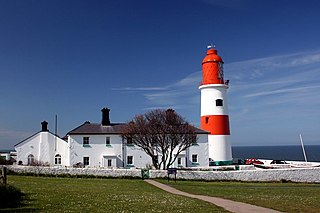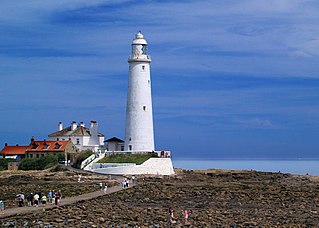
Tyne and Wear is a ceremonial county in North East England. It borders Northumberland to the north and County Durham to the south, and the largest settlement is the city of Newcastle upon Tyne.

Gateshead is a town in the Gateshead Metropolitan Borough of Tyne and Wear, England. It is on the River Tyne's southern bank. The town's attractions include the twenty metre tall Angel of the North sculpture on the town's southern outskirts, The Glasshouse International Centre for Music and the Baltic Centre for Contemporary Art. The town shares the Millennium Bridge, Tyne Bridge and multiple other bridges with Newcastle upon Tyne.

South Tyneside is a metropolitan borough in the metropolitan county of Tyne and Wear, England. It is bordered by all four other boroughs in Tyne and Wear: Gateshead to the west, Sunderland in the south, North Tyneside to the north and Newcastle upon Tyne to the north-west. The border county of Northumberland lies further north. The borough was formed on 1 April 1974 by the merger of the County Borough of South Shields with the municipal borough of Jarrow and the urban districts of Boldon and Hebburn from County Durham.

North Tyneside is a metropolitan borough in the metropolitan county of Tyne and Wear, England. It forms part of the greater Tyneside conurbation. North Tyneside Council is headquartered at Cobalt Park, Wallsend.

The Tyne and Wear Metro is an overground and underground light rail rapid transit system serving Newcastle upon Tyne, Gateshead, North Tyneside, South Tyneside, and the City of Sunderland. It has been described as the "first modern light rail system in the United Kingdom". The system is currently both owned and operated by the Tyne and Wear Passenger Transport Executive (Nexus), thus is fully under public ownership and operation.

South Shields is a coastal town in South Tyneside, Tyne and Wear, England; it is on the south bank of the mouth of the River Tyne. The town was once known in Roman times as Arbeia and as Caer Urfa by the Early Middle Ages. In 2021 it had a population of 75,337. It is the fourth largest settlement in Tyne and Wear, after Newcastle upon Tyne, Sunderland and Gateshead.

Tynemouth is a coastal town in the metropolitan borough of North Tyneside, in Tyne and Wear, England. It is located on the north side of the mouth of the River Tyne, hence its name. It is 8 mi (13 km) east-northeast of Newcastle upon Tyne. The medieval Tynemouth Priory and Castle stand on a headland overlooking both the mouth of the river and the North Sea, with the town centre lying immediately west of the headland.

North Shields is a town in the borough of North Tyneside in Tyne and Wear, England. It is 8 miles (13 km) north-east of Newcastle upon Tyne and borders nearby Wallsend and Tynemouth.
Custom House or Customs House may refer to:

South Shields is a borough constituency represented in the House of Commons of the Parliament of the United Kingdom. It elects one Member of Parliament (MP) by the first past the post system of election. It has been represented by Emma Lewell-Buck of the Labour Party since 2013.

The Tyneside Electrics were the suburban railways on Tyneside that the North Eastern Railway and the London and North Eastern Railway electrified using the third rail system. The North Tyneside Loop was electrified from 1904 onwards and formed one of the earliest suburban electric networks; the South Tyneside line to South Shields via Pelaw was electrified in March 1938. British Railways converted these lines to diesel operation in the 1960s: the line to South Shields in January 1963 and the North Tyneside lines in June 1967 when the electrical supply infrastructure and the rolling stock had become life expired. In addition, the system was losing passengers and suffering from costly vandalism. Since the late 1970s, much of the system has been converted to form the Tyne and Wear Metro.
The Blyth and Tyne Railway was a railway company in Northumberland, England, incorporated by act of Parliament on 30 June 1852. It was created to unify the various private railways and waggonways built to carry coal from the Northumberland coalfield to Blyth and the River Tyne, which it took control of on 1 January 1853. Over time, the railway expanded its network to reach Morpeth (1857/8), North Seaton (1859), Tynemouth (1860/1), Newcastle upon Tyne (1864), and finally Newbiggin-by-the-Sea (1872). It became part of the much larger North Eastern Railway in 1874.

Tyne Metropolitan College is a college of further education in North Tyneside, England.

South Shields Interchange is Tyne and Wear Passenger Transport Executive's transport hub in the coastal town of South Shields, South Tyneside in Tyne and Wear, England.

The River Tyne Police was a police force established under the Newcastle upon Tyne Port Act 1845 which patrolled the River Tyne in England between 1845 and 1968.

Clifford's Fort was a defensive gun battery established near the mouth of the Tyne during the Anglo-Dutch Wars in the 17th century. It subsequently served as a submarine mining depot and survives today as a Scheduled Ancient Monument in the historic Fish Quay area of North Shields, Tyne and Wear, in North East England.

North Tyneside Council, or North Tyneside Metropolitan Borough Council, is the local authority for the metropolitan borough of North Tyneside in Tyne and Wear, England. It is a metropolitan borough council and provides the majority of local government services in the borough. The council has been a member of the North East Combined Authority since 2024.

South Tyneside Council is the local authority of for the metropolitan borough of South Tyneside in the ceremonial county of Tyne and Wear in North East England. It is one of five metropolitan boroughs in Tyne and Wear and one of 36 in England. It provides the majority of local government services in South Tyneside. The council has been under Labour majority control since 1979. It is based at South Shields Town Hall. The council is a constituent member of the North East Mayoral Combined Authority.

South Gosforth Traction Maintenance Depot is a vehicle cleaning, maintenance and stabling facility used by the Tyne and Wear Metro, located in Gosforth, Newcastle upon Tyne in Tyne and Wear, England.





















